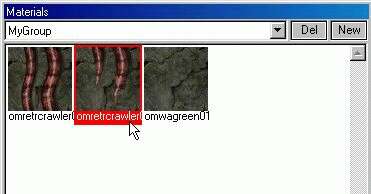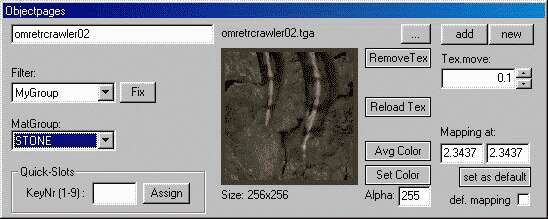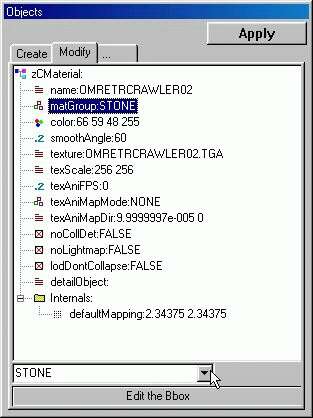| Documentation | GOTHIC |
| Materials and Textures | |
| Author: Bert Speckels | Version: August 14th 2001 |
Content
|
1 TexturingIn order to texture a level or objects, one proceeds as follows:
2 MaterialsThe Material editor is an important tool in the EditorMode of the Spacer. A material has a texture as its most important attribute. Additional important attributes can be set either in the Material editor or in the objects dialogue. 2.1 Material Pool and Material List
In the Material list the available materials are listed. The Spacer manages a material pool, which is divided into different material filters. In the file Matlib.ini (in _work/tools/data) the single filters are saved. For every filter a pml-file is created there, that contains all the materials. Saving the material pool can be performed via the settings menu (Save Material filter). If a texture from a level cannot be allocated to a filter, it lands in the TRASH filter at first. With the buttons NEW and DEL in the material list new filters can be created or existing ones removed. Applying materials to a filter happens in the material editor. In order to load a material into the material editor or the objects dialogue respectively, it suffices a simple mouse click unto the desired material in the list. 2.2 Material Editor The Material editor offers several possibilities, which in short are listed here:
The Material editor offers several possibilities, which in short are listed here:
We want to create a new material now. For this we click on the Button NEW and type a namen for the material. After this we can also choose, in which material filter it should be saved. (Bug alarm: Do not close the window via the closing X!). Now we can assign a texture (Button "...") and other attributes to the Material. The material can simply removed again, by assigning it the filter "TRASH" (hence the name). Now we want to take a bit of a simpler path to create materials. Especially we want to create several at one stroke now. For this we use the ADD button in the material editor. Now opens a file-selection dialogue, with which we select us the textures, that we want to load as a new material into the material pool. A selection of several textures is possible. After we confirmed the selected textures, appears again the familiar dialogue for the selection of a filter. One can the materials...
Now we want to assign existing materialien to a filter. For this there is the selection box "Filter" in the material editor. Now it is easy to move a single material into a filter. But it becomes more cumbersome, if we want to do this with quite a number of materials. For this we can activate at a Texture from the targeted filter the button FIX. Then for every mouse click in the material list the clicked material will be moved into the fixed filter. Another subdivision of the materials happens in the form of fixed preset material groups. These define several additional attributes of the material (e.g. footstep sounds). The QuickSlots were introduced to allow for the simple texturing in the freelook mode (F3 key). Because in this mode the polygons can be selected very comfortable with the mouse (left mouse button) and assigned to a selected texture (right mouse button). With the Quickslot-keys (1-9) it is now possible to select maximally 9 materials directly, without to get out of the freelook mode.
Additional settings in the material editor define the mapping, with which the material texture is laid unto the polygons (see "texturing") as well as the subtlety, with which the textures can be moved ("Tex.Move"). The colour of a material indicates, how it should be drawn, if the texture is not displayed (e.g. when the texture hasn't been found). Here in most cases the average colour (Avg.Color) lends itself the best. The colour is displayed as a corresponding, coloured frame around the texture in the material editor. The Alpha-Value of a texture exclusively specifies the transparency of a texture: 0 = completely transparent, 255 = completely intransparent. 2.3 Material Attributes
A few more setting can be done in the objects dialogue (when Editing do not forget the APPLY button!). The single fields are explained in the Online-Help of the Spacer (see help window) quite well. End. Do it well and thanks for the fish. |